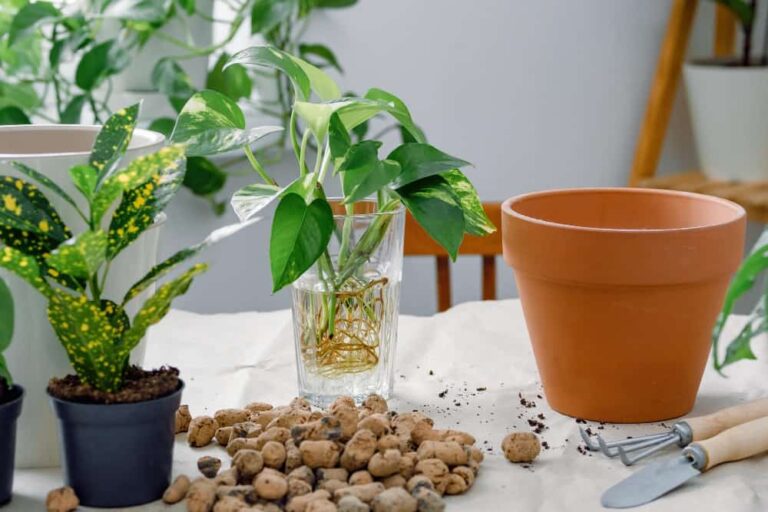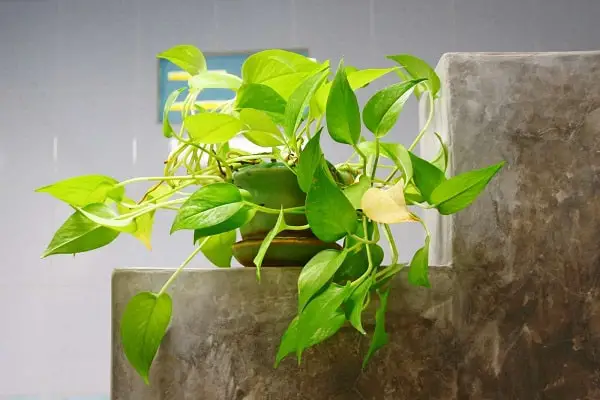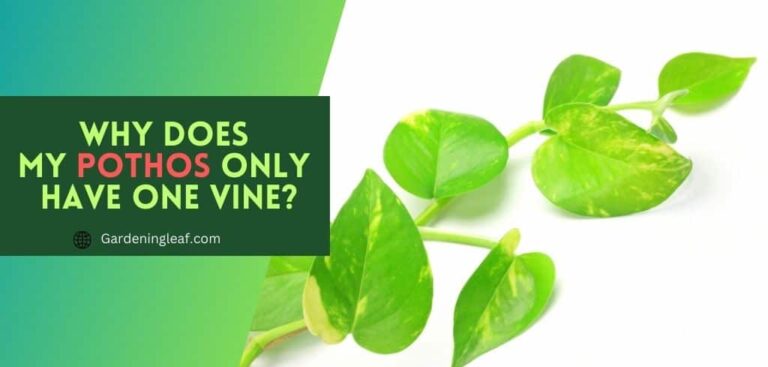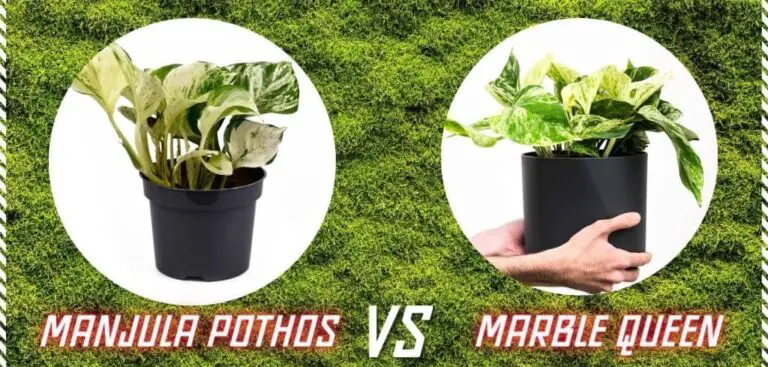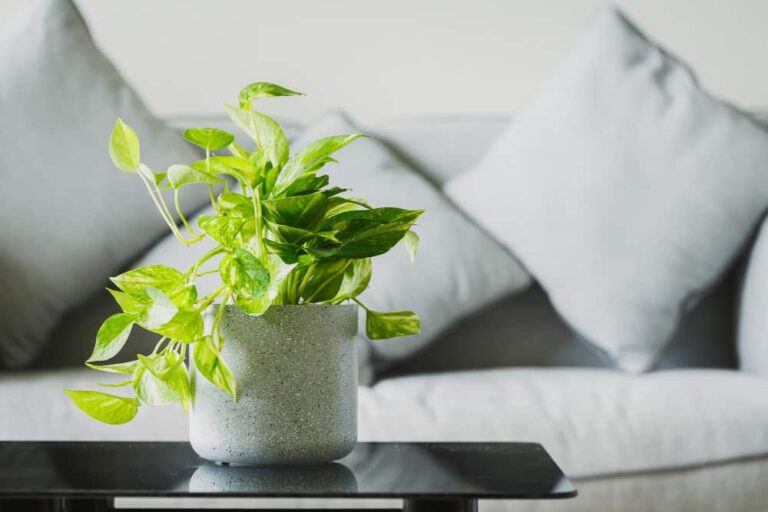Marble Queen vs Golden Pothos : The Face-Off
The Marble Queen and Golden Pothos are among the most common indoor plants. Both are easy to care for and thrive in various conditions. They are perfect for beginning gardeners and experienced green thumbs alike.
Marble Queen vs Golden Pothos is a battle of two of the most famous houseplants. Both plants are popular due to their beautiful trailing vines, attractive foliage, and ability to flourish in various environments.
One of the oldest and most famous Pothos cultivars is Marble Queen. It has served as a parent plant for developing several new cultivars. It includes Pearls, Jade, and N’Joy.
Here We will do an in-depth analysis of Marble Queen vs. Golden Pothos, including their growth rate, light requirements, and native areas. We will also cover tips and tricks for caring for your pothos plants, such as ideal soil and pot type.
Read More : – Manjula Pothos vs Marble Queen: Which One is Best for You?
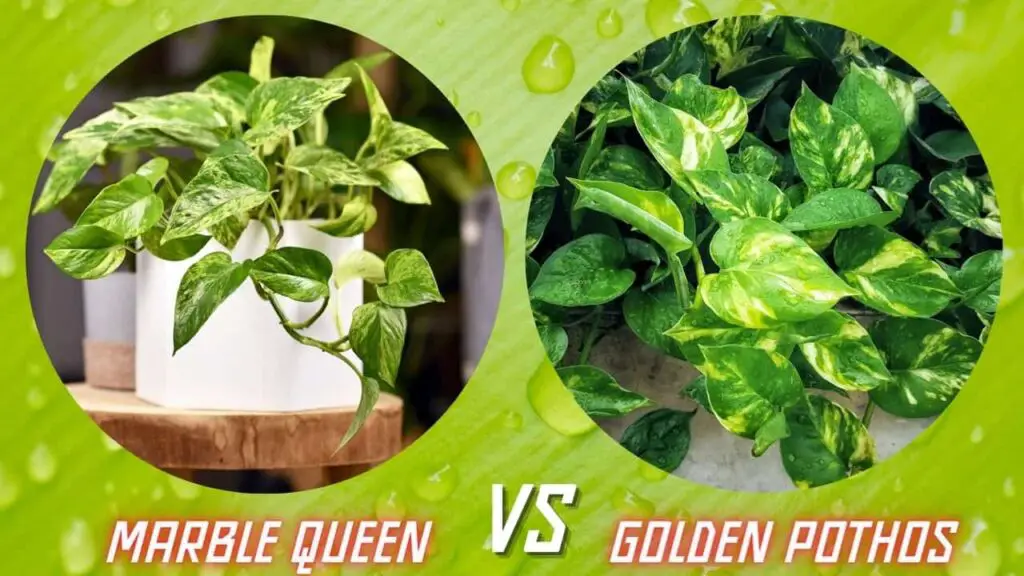
| Property | Marble Queen | Golden Pothos |
|---|---|---|
| Scientific Name | Epipremnum aureum ‘Marble Queen’ | Epipremnum aureum |
| Common Name | Marble Queen | Golden Pothos |
| Foliage | Variegated, white and green marbled | Solid green, heart-shaped |
| Growth | Climbing or trailing, up to 6 feet long | Climbing or trailing, up to 40 feet long |
| Light Requirements | Bright, indirect light | Low to bright, indirect light |
| Watering | Allow top inch of soil to dry before watering | Allow top 2-3 inches of soil to dry before watering |
| Toxicity | Toxic to pets and humans if ingested | Toxic to pets and humans if ingested |
| Maintenance | Low maintenance, occasional pruning | Low maintenance, occasional pruning |
| Propagation | Stem cuttings | Stem cuttings, division, or layering |
| Best For | Hanging baskets, plant stands | Hanging baskets, plant stands, or climbing poles |
Marble Queen vs Golden Pothos: Differences
Pothos plants are also called devil’s ivy and Money Plants. The original Pothos plant is called Golden Pothos because its scientific name, Epipremnum aureum, means gold. It used to be called Pothos aureus, Rhaphidophora aurea, and Epipremnum pinnatum before the name was settled. Marble Queen is a Pothos plant with a genetic mutation that gives it a unique variegation pattern. It’s closely related to the original Golden Pothos and has been used to create new Pothos plants, like Pearls Jade and N’Joy.
Foliage
One notable thing that differentiated them was the color and pattern of their leaves. Marble Pothos is known for its white variegation and light green heart-shaped leaves. It has a more refined, marble-like look. It has a lower percentage of green coloration and a higher percentage of creamy white. The variegation is smaller and more spread, giving it a speckled look. The marbled look is caused by the mix of green and milky white variegation, from which they get their name.
The Golden Pothos has golden and green leaves that vary from mild to dark. The leaves are medium to dark green with yellow variegation. The variegation is usually in larger patches and tends to be more uniform than the speckled pattern of Marble Queen Pothos.
Growth
When comparing Marble Queen vs Golden Pothos. One notable difference is their growth habits and plant size. Both plants can grow to large sizes in the right conditions. The height of a potted Pothos can reach 10 feet, whereas, in its native environment, it can reach 40 feet.
But, the Golden Pothos typically grows faster than the Marble Queen Pothos. With the proper amount of light and fertilization, its reported growth rates are up to 12 inches a month. This is due to its ability to produce more chlorophyll in its leave, which allows it to carry out photosynthesis more efficiently.
While the Marble Queen Pothos may grow slower due to the lack of chlorophyll in its leaves, it can still grow well when given adequate light, water, and fertilizer. The patterned leaves of the Marble Queen Pothos also add a unique aesthetic to any indoor environment.
Taxonomy
Marble Queen Pothos has more bright color and does well in direct sunlight. It has heart-shaped leaves that are spotted with white. Golden Pothos has more solid dark green leaves with occasional yellow variegation.
Marble Queen and Golden Pothos have different types of variegation. Marble Queen has bigger and brighter white markings that stand out more against the green leaves. On the other hand, Golden Pothos has a softer and less distinct variegation.
Light Requirements
Another key distinction between them is their light requirements. Due to its more variegated look, Marble Queen Pothos needs brighter light than Golden Pothos to ensure that the light-colored parts of the leaves can photosynthesize enough to produce food. Golden Pothos can grow in lower light. But thrive where they get plenty of bright, indirect light.
Watering:
Marble Queen requires slightly moister soil than Golden Pothos to thrive. This is because the variegated leaves contain less chlorophyll than Golden Pothos. It’s making the plant less efficient at producing energy from sunlight. Moist can help ensure the plant has enough water to support its growth and maintain healthy foliage. But, overwatering can be detrimental to the plant. Marble Queen can also enjoy occasional misting or placement in a more humid environment to promote healthy growth.
Read More : – How to Grow Pothos in Water: The Ultimate Guide
Marble Queen vs Golden Pothos: similarities
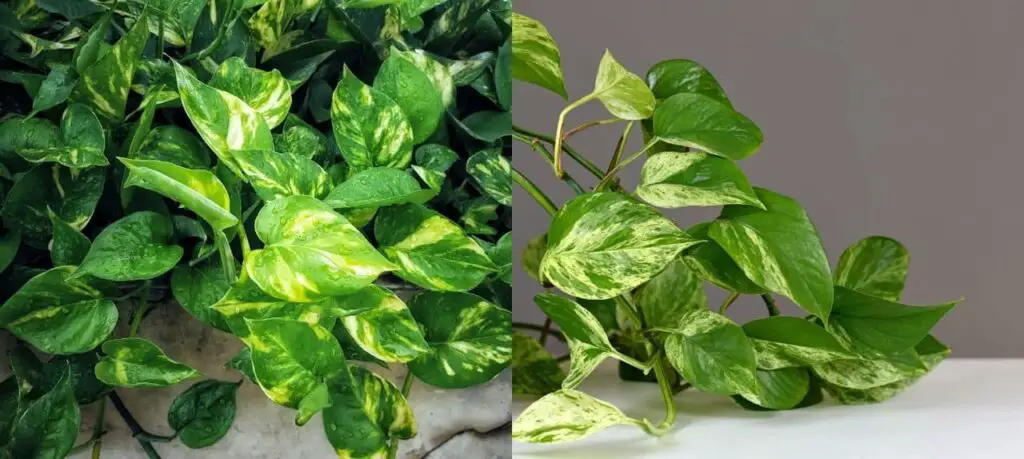
Despite their differences in appearance, They share a few similarities.
Leaf Texture
They have some similarities, including leaf shape and texture. The leaves of both plants are similarly thick, waxy, and heart-shaped. Which aids in their capacity to retain water. The thick, waxy leaves protect the plant from harmful insects and bacteria.
This is because the leaves are harder for insects to penetrate, and the waxy coating makes it harder for fungal spores to adhere to and grow. Furthermore, the waxy texture of the leaves can make cleaning and maintenance easier. as dust and debris are less likely to stick to the surface.
Toxicity
Marble Queen and Golden Pothos are similar in their toxicity level. They are similar in that they both contain Calcium Oxalate. If eaten orally, it can lead to irritation and discomfort. It’s important to handle both plants with care and wear gloves when pruning, as they can cause skin irritation. But, Golden Pothos is known for its more vigorous climbing ability. While Marble Queen requires brighter light to thrive and has less green coloration. Despite these differences, both plants make great indoor houseplants and offer unique benefits.
Easy to care for:
Both Marble Queen and Golden Pothos are low-maintenance plants. They can tolerate light and humidity conditions, making them ideal for beginners and busy individuals.
Propagation:
Pothos plants are one of the easiest to propagate plants. You can easily grow plants from stem cutting in water or soil. They are great choices for plant enthusiasts. You can grow your collection or share it with friends.
Air-purifying qualities:
Both plants are excellent air-purifying plants, which means they can help remove harmful pollutants and toxins from indoor air. They enhance indoor air quality and provide a healthier living environment.
Read More : – How To Make Pothos Grow Faster: Basic care, plants, and more
How to Care Marble Queen and Golden Pothos
When it comes to caring, these two plants are quite similar. They both need the same basic needs. When it comes to taking care of either of these plants, the following is a more in-depth look at what you may anticipate:

Light
Both can tolerate various lighting conditions, but they have slightly different preferences. The Marble Queen thrives best in indirect bright light. But may also survive in environments with medium light levels. Doint place them in direct sunlight. Otherwise, the leaves could get burned. On the other hand, Golden Pothos can tolerate a wider range of lighting conditions, including low light, but it will grow faster and produce more variegation in bright, indirect light. Direct sunlight can also cause damage to the leaves of Golden Pothos, so it’s important to protect it from the hot afternoon sun.
Water
Marble Queen prefers slightly moister soil to Golden Pothos. So you should allow the top inch of soil to dry before watering Marble Queen and the top 2-3 inches before watering Golden Pothos.. Using a well-draining potting mix and water thoroughly is recommended, but make sure to let excess water drain away.
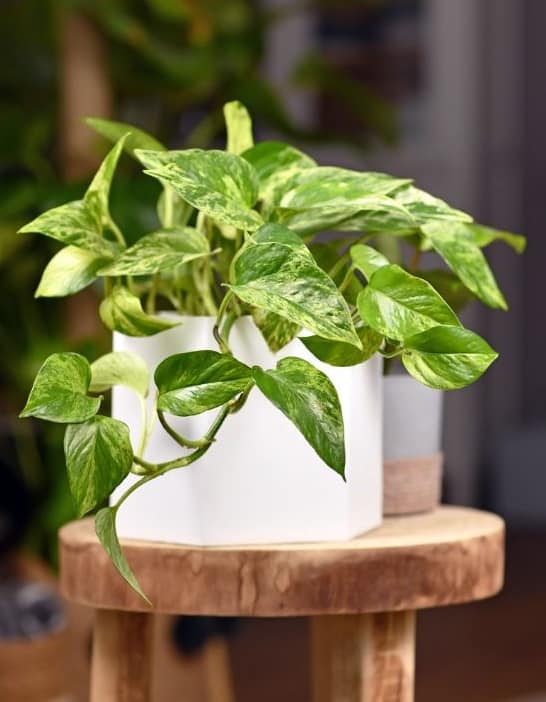
Soil
Both require well-draining soil that allows for good moisture retention but not waterlogging. A potting mix that includes peat moss, perlite, and bark chips is recommended for both types of Pothos to promote optimal growth and health.
Temperature and Humidity
Golden Pothos prefers temperatures between 18°C and 30°C. They are a great fit for most indoor environments. Additionally, it is less demanding than Marble Queen Pothos of humidity.
Marble Queen Pothos requires a higher level of humidity than Golden Pothos. The ideal temperatures range from 21°C to 32°C. Keep your Marble Queen Pothos in a location with moderate to high humidity and avoid exposure to cold temperatures.
Fertilizer
Marble Queen and Golden Pothos are both relatively low-maintenance plants that don’t require frequent fertilization. You can fertilize them once every 2-3 months during their active growing season to promote healthy growth.
Use a water-soluble fertilizer with equal nitrogen, phosphorus, and potassium ratio. Overfertilization can create salt accumulation in the soil and root burn. Following the manufacturer’s dosage and application frequency instructions is also important.
Pruning
Regular pruning is important to caring for Marble Queen and Golden Pothos plants. It is recommended to prune these plants in early spring or late winter by cutting back the stems to the desired height. To promote new growth, cut the stems just above a node.
Read More : – How To train Pothos to Climb: Useful Beginner’s Guide
FAQs
What is the rarest type of pothos?
Some of the rarest types of Pothos include Jade Pothos, Pearls Pothos, Jessenia Pothos, and Harlequin Pothos. There are wide other unique varieties Neon pothos, Satin, Manjula, and Cebu Blue Pothos are a few other well-known varieties.
Which is better marble Queen or snow Queen Pothos?
Both plants are adorable and easy to care for. However, the Snow Queen Pothos is the more popular choice as it has cream, white, and green foliage and is a more vigorous grower. The Marble Queen Pothos has more of a traditional marbled look and is not as vigorous as the Snow Queen. Both plants enjoy bright, indirect light and need regular watering and trimming to keep them looking their best.
How do I identify a marble queen pothos?
To identify a Marble Queen Pothos, look for its distinctive variegated foliage. Its leaves should be a mix of green and white, with the white sections appearing as splotches or stripes. The Marble Queen Pothos should also have larger, glossy, heart-shaped leaves.
Which pothos is best for beginners?
In general, pothos plants are excellent first houseplants due to their durability and ease of maintenance. However, the Golden Pothos is considered the best choice for beginners because it is very forgiving regarding watering and light levels. It can grow in low light conditions and go without water for long periods. Additionally, it has beautiful green foliage that adds life to any space.
Conclusion
Marble Queen and Golden Pothos are popular houseplants known for their air-purifying qualities and ease of care. Both plants belong to the Scindapsus genus and share the common name of Pothos. The main difference between Marble Queen vs Golden Pothos lies in their variegation.
Marble Queen has broader white markings that contrast more with the green color. While Golden Pothos has softer, chartreuse variegation. About care, Marble Queen prefers moister soil, and both plants need a well-draining potting mix with good moisture retention. Proper watering and pruning are also essential for optimal growth and health. No matter whatever plant you pick. Both plants are very bountiful and easy to maintenance.
Source :- Thespruce.com


